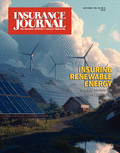The catastrophic floods in central Texas on July 4th occurred in an area where fewer than 3% of homeowners have flood insurance through the National Flood Insurance Program, serving as another example of why Texas has one of the highest risk profiles of any state, according to an analysis by the Insurance Information Institute (Triple-I).
The Triple-I’s analysis, Texas: A Complex Mix of Risks, finds that the Lone Star State faces a unique combination of natural catastrophe risks, driven by severe convective storms, lightning and hail damage, wildfire risk, grid vulnerability and flooding.
“The catastrophic flooding in Central Texas exemplifies a troubling trend we have seen with events like hurricanes Harvey, Ida, Ian and Helene – devastating flood damage occurring far from storm landfall,” said Patrick Schmid, Triple-I’s chief insurance officer. “In Kerr County, where the worst flooding occurred during the recent Hill Country disaster, only 2.5% of homeowners have flood insurance through the National Flood Insurance Program.”
Approximately 466 NFIP contracts are in force in Kerr County out of 21,349 total residential structures, data compiled by private flood insurer Neptune Flood found.
The lack of properties with flood coverage reflects the state’s wider insurance affordability crisis, the Triple-I’s analysis found.
Texas experiences the most tornadoes and hail events of any state and has the third-most homes at risk for extreme wildfire behind California and Colorado. The Triple-I pointed to lightning loss claims as another contributor to the state’s rising homeowners’ insurance costs. Texas recorded 4,369 homeowners’ insurance lightning loss claims in 2024, second only to Florida, with an average cost per claim of $38,558
The combined vulnerabilities of these risks are reflected in how much Texans are paying for homeowners and auto insurance, the Triple-I found.
Texans spend an average 3.13% of median income on homeowners’ insurance, according to the Insurance Research Council (IRC), which is 6th-most nationally. An average 1.65% of median income is spent on auto insurance, 14th-most in the country.
“All insurance pricing needs to reflect the risk inherent in the coverage provided,” said Schmid. “For Texas homeowners, their poor affordability reflects the high levels of natural catastrophe risk – most notably, severe convective storms and hurricanes. Improving the resilience of homes, businesses, and communities is essential to reduce the risk, improve affordability, and save lives.”
Photo: Search and rescue teams from Kerrville Fire Department walk past debris after flooding near the banks of the Guadalupe River in Kerrville, Texas on Tuesday, July 8, 2025. (AP Photo/Ashley Landis)
Was this article valuable?
Here are more articles you may enjoy.



 State Farm Implements 27% Rate Increase for Illinois Homeowners
State Farm Implements 27% Rate Increase for Illinois Homeowners  Villages Health System Sees $350 Million in Medicare Overcharges
Villages Health System Sees $350 Million in Medicare Overcharges  Nursing Homes Struggle With Trump’s Immigration Crackdown
Nursing Homes Struggle With Trump’s Immigration Crackdown  Louisiana Insurers Must Disclose Prior Policy Premiums Under Controversial New Law
Louisiana Insurers Must Disclose Prior Policy Premiums Under Controversial New Law 

